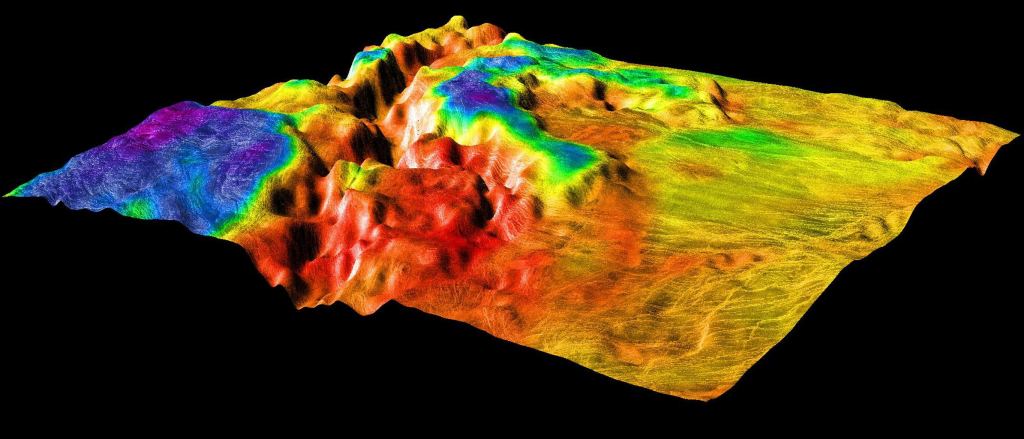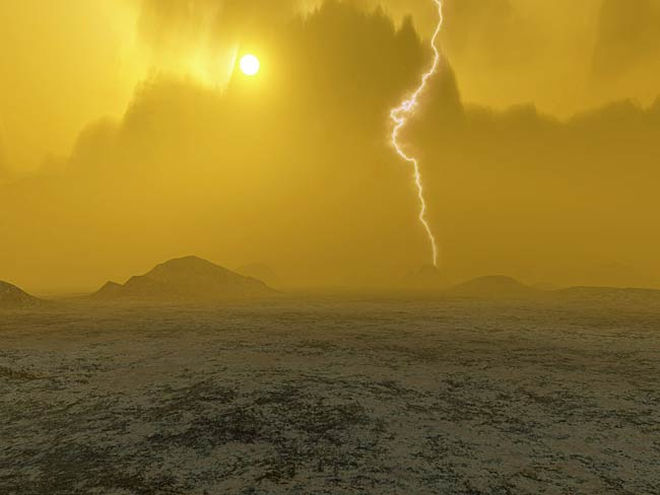Venus is often referred to as “Earth’s sister planet“, owing to the number of similarities between them. Like Earth, Venus is a terrestrial (aka. rocky) planet and it resides with our Sun’s Circumstellar Habitable Zone (CHZ). And for some time, scientists have theorized that billions of years ago, Venus had oceans on its surface and was habitable – aka. not the hot and hellish place it is today.
However, after examining radar data on the Ovda Fluctus lava flow, a team scientists at the Lunar and Planetary Institute concluded that the highlands on Venus are likely to be composed of basaltic lava rock instead of granite. This effectively punches a hole in the main argument for Venus having oceans in the past, which is that the Ovda Regio highlands plateau formed in the presence of water.
The study that describes their findings (and includes a new map of the highlands plateau) recently appeared in the Journal of Geophysical Research: Planets. The study was conducted by members of the LPI with the assistance of undergraduate student intern Frank Wroblewski (from Northland College), and Prof. Tracy K.P. Gregg of the University of Buffalo.

Ovda Regio, a crustal plateau near the equator in the western region of Aphrodite Terra, is the largest formation of its kind on Venus. Between 1989 and 1994, the region was mapped extensively by NASA’s Magellan spacecraft. This mission would be the first to use synthetic aperture radar (SAP) to map the surface of Venus and measure its planetary gravitational field.
At the time, scientists believed that the highlands were composed of granite rock – which requires the presence of oceans to form. Combined with the chemistry of the atmosphere, scientists theorized that the presence of these highlands were evidence of a past ocean. However, after remapping the Ovda Fluctus lava flow and examining its morphology and geologic setting, the LPI team concluded it was likely to be basaltic in composition.
Unlike granite, basalt rock is linked to volcanic activity and can form with or without water. These result could significant implications for the evolutionary history of Venus, particularly when it comes to questions of its habitability.
“We know so little about Venus’ surface. If the Ovda Regio highlands are made of basaltic rock as is most of Venus, they were likely squeezed up to their current heights by internal forces, possibly like mountains which result from plate tectonics on Earth.”

This study began in 2018 as part of the LPI’s Summer Intern Program, a 10-week program that provides undergraduate students with the opportunity to participate in cutting edge research. These students are paired with scientists from the LPI or the Astromaterials Research and Exploration Science (ARES) Division at the NASA Johnson Space Center.
Venus was not always the type of world that it is today, where the atmosphere is extremely hot and toxic and the surface is hot enough to be viscous. However, roughly 700 million years ago, a geological event occurred that caused 80% of the planet to resurface. This event is thought to have forced massive amounts of CO² into the atmosphere, triggering a runaway greenhouse effect.
According to recent research, however, Venus would have had a habitable environment for billions of years prior. It has also been suggested that it was the presence of a planet-wide ocean that caused Venus’ rotation to slow down. This would be why the planet currently takes over 243 days to complete a single rotation on its axis (and in the opposite direction as the other planets).
As such, these findings could be seen as something of a downer. But more to the point, they represent something of a complication. Venus may very well have been habitable for billion of years before resurfacing changed it. But for now, it appears that a major argument in favor of this scenario is in dispute.
In the coming decade, more missions are planned that will go to Venus and study its atmosphere and surface in more detail. Hopefully, what they find will shed more light on its surface features and tell us more about its past – in particular, whether it was warm or watery!
Further Reading: USRA


Just a quickie since I haven’t had time to read the paper.
But apriori it looks like a local flood basalt, like those that build the Massif Central mountain range covering 15 % of France [ https://en.wikipedia.org/wiki/Massif_Central ]. In any case the local evidence is weaker than the recent published global atmosphere and highland presence suggesting long periods of water.
Besides, and again I haven’t read the paper, the article can be read as that the authors want to have the cake and eat it too. On Earth plate tectonics is tied to water conditions:
“”If the Ovda Regio highlands are made of basaltic rock as is most of Venus, they were likely squeezed up to their current heights by internal forces, possibly like mountains which result from plate tectonics on Earth.”